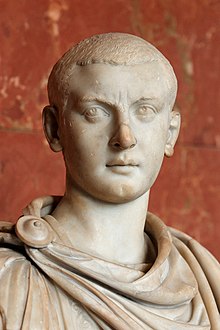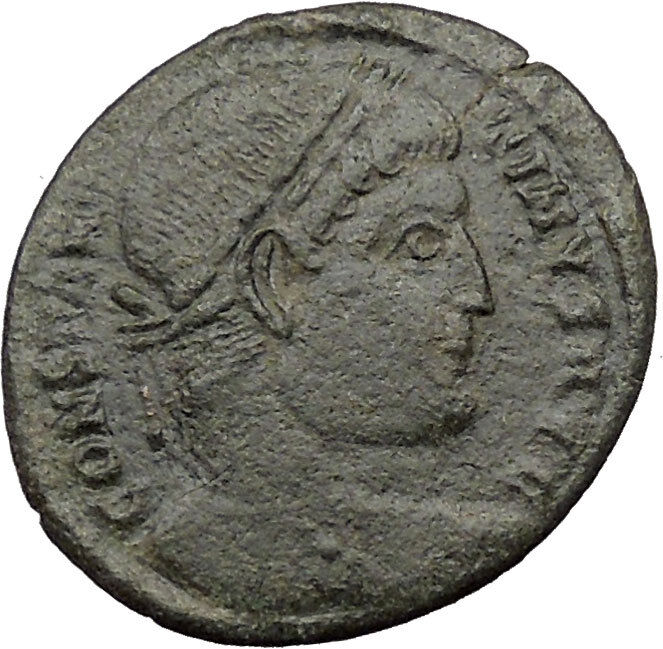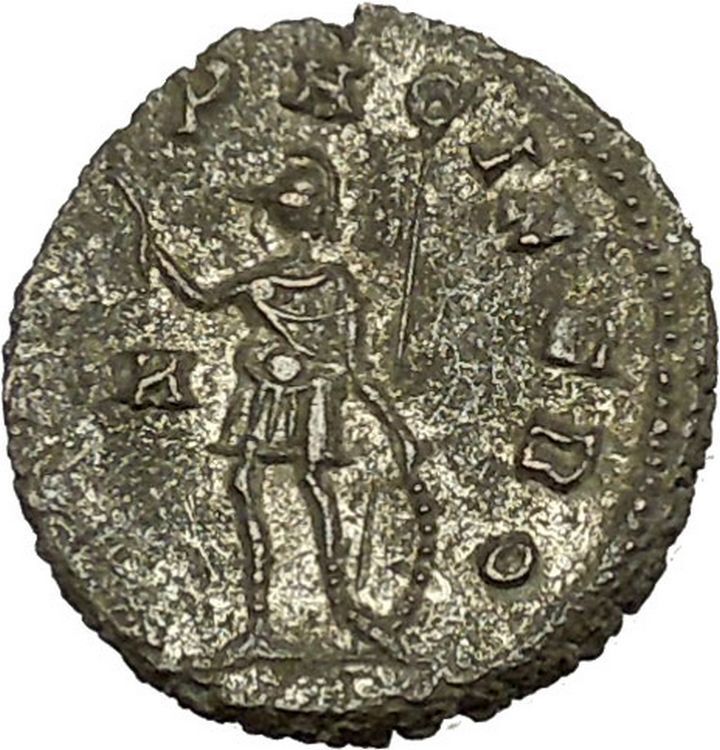|
Gordian III – Roman Emperor: 238-244 A.D.
Silver Antoninianus 22mm (2.35 grams) Rome mint: 238 A.D.
Reference: RIC 1, C 86
IMPCAESMANTGORDIANVSAVG – Radiate, draped and cuirassed bust right.
FIDESMILITVM – Fides standing, facing, holding standard and scepter.
You are bidding on the exact item pictured, provided with a Certificate of Authenticity and Lifetime Guarantee of Authenticity.
In Roman religion, Fides was the goddess of trust.
Her temple on the Capitol was where the Roman Senate signed and kept state treaties with foreign countries, and where Fides protected them.
She was also worshipped under the name Fides Publica Populi Romani (“Public (or Common) Trust of the Roman People”). She is represented by a young woman crowned with an olive branch, with a cup or turtle, or a military ensign in hand. She wears a white veil or stola; her priests wore white cloths, showing her connection to the highest gods of Heaven, Jupiter and Dius Fidius. Her temple which can be dated to 254 B.C.E was near Jupiter’s temple in the Capitol.
Traditionally Rome’s second king, Numa Pompilius instituted a yearly festival devoted to Fides, and established that the major priests (the three flamines maiores) be borne to her temple in a covered arched chariot drawn by two horses. There they should conduct her services with their heads covered and right hands wrapped up to the fingers to indicate absolute devotion to her and to symbolise trust.[1]
Her Greek equivalent was Pistis.
Standards

Roman military standards. The standards with discs, or signa (first three on left) belong to centuriae of the legion (the image does not show the heads of the standards – whether spear-head or wreathed-palm). Note (second from right) the legion’s aquila. The standard on the extreme right probably portrays the She-wolf (lupa) which fed Romulus, the legendary founder of Rome. (This was the emblem of Legio VI Ferrata, a legion then based in Judaea, a detachment of which is known to have fought in Dacia). Detail from Trajan’s Column, Rome

Modern reenactors parade with replicas of various legionary standards. From left to right: signum (spear-head type), with four discs; signum (wreathed-palm type), with six discs; imago of ruling emperor; legionary aquila; vexillum of commander (legatus) of Legio XXX Ulpia Victrix, with embroidered name and emblem (Capricorn) of legion
Each tactical unit in the imperial army, from centuria upwards, had its own standard. This consisted of a pole with a variety of adornments that was borne by dedicated standard-bearers who normally held the rank of duplicarius. Military standards had the practical use of communicating to unit members where the main body of the unit was situated, so that they would not be separated, in the same way that modern tour-group guides use umbrellas or flags. But military standards were also invested with a mystical quality, representing the divine spirit (genius) of the unit and were revered as such (soldiers frequently prayed before their standards). The loss of a unit’s standard to the enemy was considered a terrible stain on the unit’s honour, which could only be fully expunged by its recovery.
The standard of a centuria was known as a signum, which was borne by the unit’s signifer. It consisted of a pole topped by either an open palm of a human hand or by a spear-head. The open palm, it has been suggested, originated as a symbol of the maniple (manipulus = “handful”), the smallest tactical unit in the Roman army of the mid-Republic. The poles were adorned with two to six silver discs (the significance of which is uncertain). In addition, the pole would be adorned by a variety of cross-pieces (including, at bottom, a crescent-moon symbol and a tassel). The standard would also normally sport a cross-bar with tassels.
The standard of a Praetorian cohort or an auxiliary cohort or ala was known as a vexillum or banner. This was a square flag, normally red in colour, hanging from a crossbar on the top of the pole. Stitched on the flag would be the name of the unit and/or an image of a god. An exemplar found in Egypt bears an image of the goddess Victory on a red background. The vexillum was borne by a vexillarius. A legionary detachment (vexillatio) would also have its own vexillum. Finally, a vexillum traditionally marked the commander’s position on the battlefield.[194] The exception to the red colour appears to have been the Praetorian Guard, whose vexilla, similar to their clothing, favoured a blue background.
From the time of Marius (consul 107 BC), the standard of all legions was the aquila (“eagle”). The pole was surmounted by a sculpted eagle of solid gold, or at least gold-plated silver, carrying thunderbolts in its claws (representing Jupiter, the highest Roman god. Otherwise the pole was unadorned. No exemplar of a legionary eagle has ever been found (doubtless because any found in later centuries were melted down for their gold content). The eagle was borne by the aquilifer, the legion’s most senior standard-bearer. So important were legionary eagles as symbols of Roman military prestige and power, that the imperial government would go to extraordinary lengths to recover those captured by the enemy. This would include launching full-scale invasions of the enemy’s territory, sometimes decades after the eagles had been lost e.g. the expedition in 28 BC by Marcus Licinius Crassus against Genucla (Isaccea, near modern Tulcea, Rom., in the Danube delta region), a fortress of the Getae, to recover standards lost 33 years earlier by Gaius Antonius, an earlier proconsul of Macedonia. Or the campaigns of AD 14-17 to recover the three eagles lost by Varus in AD 6 in the Teutoburg Forest.
Under Augustus, it became the practice for legions to carry portraits (imagines) of the ruling emperor and his immediate family members. An imago was usually a bronze bust carried on top of a pole like a standard by an imaginifer.
From around the time of Hadrian (r. 117-38), some auxiliary alae adopted the dragon-standard (draco) commonly carried by Sarmatian cavalry squadrons. This was a long cloth wind-sock attached to an ornate sculpture of an open dragon’s mouth. When the bearer (draconarius) was galloping, it would make a strong hissing-sound.
Decorations
The Roman army awarded a variety of individual decorations (dona) for valour to its legionaries. Hasta pura was a miniature spear; phalerae were large medal-like bronze or silver discs worn on the cuirass; armillae were bracelets worn on the wrist; and torques were worn round the neck, or on the cuirass. The highest awards were the coronae (“crowns”), of which the most prestigious was the corona civica, a crown made oak-leaves awarded for saving the life of a fellow Roman citizen in battle. The most valuable award was the corona muralis, a crown made of gold awarded to the first man to scale an enemy rampart. This was awarded rarely, as such a man hardly ever survived.
There is no evidence that auxiliary common soldiers received individual decorations like legionaries, although auxiliary officers did. Instead, the whole regiment was honoured by a title reflecting the type of award e.g. torquata (“awarded a torque”) or armillata (“awarded bracelets”). Some regiments would, in the course of time, accumulate a long list of titles and decorations e.g. cohors I Brittonum Ulpia torquata pia fidelis c.R..

Gordian III – Roman Emperor: 238-244 A.D.
Caesar: 238 A.D. (under Balbinus and Pupienus)
Augustus: 238-244 A.D.
| Grandson of Gordian I | Nephew of Gordian II | Adopted Successor of Balbinus and Pupienus | Husband of Tranquillina |
Marcus Antonius Gordianus Pius (January 20, 225 – February 11, 244), known in English as Gordian III, was Roman Emperor from 238 to 244. Gordian was the son of Antonia Gordiana and his father was an unnamed Roman Senator who died before 238. Antonia Gordiana was the daughter of Emperor Gordian I and younger sister of Emperor Gordian II. Very little is known on his early life before becoming Roman Emperor. Gordian had assumed the name of his maternal grandfather in 238.
Following the murder of emperor Alexander Severus in Moguntiacum (modern Mainz), the capital of the Roman province Germania Inferior, Maximinus Thrax was acclaimed emperor, despite strong opposition of the Roman senate and the majority of the population. In response to what was considered in Rome as a rebellion, Gordian’s grandfather and uncle, Gordian I and II, were proclaimed joint emperors in the Africa Province. Their revolt was suppressed within a month by Cappellianus, governor of Numidia and a loyal supporter of Maximinus Thrax. The elder Gordians died, but public opinion cherished their memory as peace loving and literate men, victims of Maximinus’ oppression.
Meanwhile, Maximinus was on the verge of marching on Rome and the Senate elected Pupienus and Balbinus as joint emperors. These senators were not popular men and the population of Rome was still shocked by the elder Gordian’s fate, so that the Senate decided to take the teenager Gordian, rename him Marcus Antonius Gordianus as his grandfather, and raise him to the rank of Caesar and imperial heir. Pupienus and Balbinus defeated Maximinus, mainly due to the defection of several legions, namely the ParthicaII who assassinated Maximinus. But their joint reign was doomed from the start with popular riots, military discontent and even an enormous fire that consumed Rome in June 238. On July 29, Pupienus and Balbinus were killed by the Praetorian guard and Gordian proclaimed sole emperor.
Rule
Due to Gordian’s age, the imperial government was surrendered to the aristocratic families, who controlled the affairs of Rome through the senate. In 240, Sabinianus revolted in the African province, but the situation was dealt quickly. In 241, Gordian was married to Furia Sabinia Tranquillina, daughter of the newly appointed praetorian prefect, Timesitheus. As chief of the Praetorian guard and father in law of the emperor, Timesitheus quickly became the de facto ruler of the Roman empire.
In the 3rd century, the Roman frontiers weakened against the Germanic tribes across the Rhine and Danube, and the Sassanid kingdom across the Euphrates increased its own attacks. When the Persians under Shapur I invaded Mesopotamia, the young emperor opened the doors of the Temple of Janus for the last time in Roman history, and sent a huge army to the East. The Sassanids were driven back over the Euphrates and defeated in the Battle of Resaena (243). The campaign was a success and Gordian, who had joined the army, was planning an invasion of the enemy’s territory, when his father-in-law died in unclear circumstances. Without Timesitheus, the campaign, and the emperor’s security, were at risk.
Marcus Julius Philippus, also known as Philip the Arab, stepped in at this moment as the new Praetorian Prefect and the campaign proceeded. In the beginning of 244, the Persians counter-attacked. Persian sources claim that a battle was fought (Battle of Misiche) near modern Fallujah (Iraq) and resulted in a major Roman defeat and the death of Gordian III. Roman sources do not mention this battle and suggest that Gordian died far away, upstream of the Euphrates. Although ancient sources often described Philip, who succeeded Gordian as emperor, as having murdered Gordian at Zaitha (Qalat es Salihiyah), the cause of Gordian’s death is unknown.
Gordian’s youth and good nature, along with the deaths of his grandfather and uncle and his own tragic fate at the hands of another usurper, granted him the everlasting esteem of the Romans. Despite the opposition of the new emperor, Gordian was deified by the Senate after his death, in order to appease the population and avoid riots.
|













